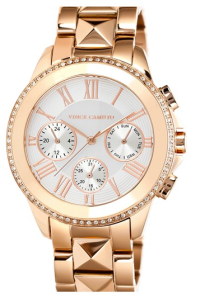Hello everyone!

I have a confession to make: I have fallen victim to the watch trend that started approximately last spring. That’s right, when everyone started buying those big, branded, sometimes oversized “runway” watches, often in the color of gold, but especially in rose
gold. The watch I purchased last February was a rose gold Vince Camuto watch with pyramid studs – yet another trend – and Swarovski crystals.
1. What meanings are commonly associated with the object? List several.
- Luxurious
- Wealth/Money
- Professional/Sophisticated
- Style/Fashion
- Organized
2. What ideologies or cultural values (stylization) might be reflected in these meanings? What systems of power are implicated in these meanings?
Capitalism and consumer culture play a great role in the meanings associated to watches. Through the production of these objects, industries have found a way to place a value on the immateriality of time and, as a result, have been able turn a profit from them. Marketing, advertising, and the fashion industry alike have convinced people that owning a watch means they are stylish and up to date on all the latest fashion trends. Inevitably, the more you pay for a watch reflects your identity and wealth. Fashion watches often fall victim to conspicuous consumption, where they are consumed and worn simply to show off a certain brand (i.e. the infamous oversized Michael Kors watches). Social and financial status, and therefore identity, are being displayed through the brands being worn; the most popular ones are often the biggest names in the fashion industry at that moment in time. Possession rituals, as discussed by Lury, help create these identities, as owners treat these objects as prized possessions; there are services available to fix watches, size them, and clean them. They are also widely found on sites such as Pintrest, Etsy, and Instagram, where people compare and show off their own watches, as well as adapting them to fit their style. Magazines and fashion blogs also display watches in accordance to different styles and offer tips on how to match certain kinds of watches with certain types of outfits.
3. Have the meanings of this object shifted over time? (objects have social lives) If so, what historical developments do you think account for the shift?
The meanings of this object definitely shifted over time (no pun intended). The history of timekeeping can be traced back to sundials; the development of the mechanical watch is therefore an innovation that developed over the centuries. The basic and most fundamental purpose of the watch is to keep and tell time. Over the years, the fashion industry has transformed this functional object into an accessory that can be designed in thousands of ways, yet they all serve the same basic purpose of timekeeping. Watches are now a fashion statement or an accent to an overall outfit that signal status and identity. A watch’s brand, details, materials, embellishments, and overall design all determine the status of the owner; the fancier and more expensive the watch is, the higher the status of its owner.
To further my point, take a look at people today that own watches. A common sight that I have experienced is seeing people who are clearly wearing watches looking to their cellphones for the time. Does this not defeat the purpose of a watch? I have asked several people that I know why they do this, and many replied by saying that they can’t even tell time mechanically! Obviously, there are still many people who wear watches for the sole purpose of keeping time. For those who sport watches as a fashion statement, however, do so to be in the loop and fit in with the latest crazes and fashion trends.
4. Would this object hold different meanings in different cultures around the world (or different subcultures within Canada)? What other meanings might it hold?
On a basic level, a watch’s function is the same across all cultures – that is, to tell time. The ways in which one may use a watch, however, can differ. They can be used as a timer, as a way to organize and plan one’s day or week, or simply to complete an outfit. The meanings associated with watches also vary, which usually come through with the design and features of a watch; markets have created different kinds of watches to attract different potential consumers. There are digital watches, mechanical, sports watches, wristwatches, and pocket watches, to name a few. Prices also vary from a couple of dollars to thousands of dollars depending on the brand and materials used. I would say that the meaning allocated through watches depending on what kind of watch it is. One that was designed for sports, for example, might hold meanings of practicality, whereas a pocket watch might hold meanings of antiquity, elegance, or sentimental value.
